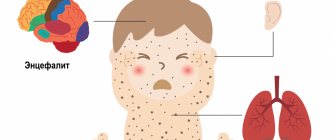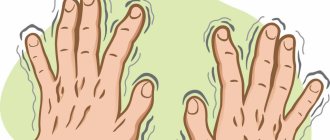ATTENTION – TICK-BORNE ENCEPHALITIS
Tick-borne encephalitis is an acute viral disease of the nervous system. Its main sources are two types of ixodid ticks - taiga and European forest ticks. The peak incidence of encephalitis occurs in spring (May-June) and late summer and early autumn (August-September).
Ticks are very fond of mixed forests with dense undergrowth, bushes, and tall grass. Prefer damp places. But they don’t like direct sunlight and dry air. In extreme heat or during heavy rain, these parasites are inactive and almost do not attack. The disease can lead to persistent neurological and psychiatric complications and even death of the patient.
Causes
Tick-borne encephalitis is sometimes called differently - spring-summer, taiga, Siberian, Russian. Synonyms arose due to the characteristics of the disease. Spring-summer, because the peak incidence occurs in the warm season, when ticks are most active. The first peak of the disease is recorded in May-June, the second - at the end of summer.
If you are bitten by an encephalitis tick, the virus enters the bloodstream within the first minutes of contact. According to statistics, six ticks out of a hundred are carriers of the virus (at the same time, from 2 to 6% of people bitten can get sick from an infected individual).
The causative agent of tick-borne encephalitis is an RNA virus belonging to the Vlaviviridae family. There are 3 types of virus:
- Far Eastern - the most virulent (can cause severe forms of the disease);
- Siberian - less contagious;
- Western - the causative agent of two-wave encephalitis - causes mild forms of the disease.
The bite of an ixodid tick is the main cause of encephalitis. Due to damage to the body by a natural focal viral infection, which is dangerous for the membranes of the brain and spinal cord, meningitis and meningoencephalitis occur.
There are known cases of human infection with tick-borne encephalitis after consuming milk from tick-infected domestic animals. Therefore, you can only drink pasteurized or boiled milk.
Features of the tick-borne encephalitis virus are its poor resistance to high temperatures, disinfectants and ultraviolet radiation. Thus, when boiled, it dies within 2 minutes and cannot be preserved in the environment in hot sunny weather. However, at low temperatures it is able to maintain viability for a long time.
Incubation period
During a tick bite, some viruses begin to multiply in the subcutaneous tissue and tissue macrophages, while another part enters the blood and penetrates the vascular endothelium, lymph nodes, parenchymal organs, and into the tissue of the central nervous system, where they intensively multiply and accumulate. Treatment of tick-borne encephalitis is carried out using many groups of drugs that affect the virus itself and all parts of the pathological process.
Traditionally, the incubation period of infection lasts from 7 to 20 days after the bite of an infected parasite, if infection occurred through milk - 3-7 days.
Sometimes fulminant forms of tick-borne encephalitis are diagnosed (the first symptoms appear within a day) and protracted forms - the incubation period can include up to 30 days.
You should know that a patient with tick-borne encephalitis is not dangerous to others, as it is not contagious.
On average, the incubation period is 1-3 weeks, since the forms of development of the disease are different:
- Lightning fast. With it, the initial symptoms appear already on the first day.
- Lingering. In this case, the duration of the incubation period can be about a month, sometimes even a little longer.
Symptoms of tick-borne encephalitis
Tick-borne encephalitis is a viral infection that initially occurs under the guise of a common cold. It may go unnoticed by the patient, or may cause severe damage to the nervous system.
After a tick bite, the virus multiplies in tissues and penetrates the lymph nodes and blood. When the virus multiplies and enters the bloodstream, flu-like symptoms form.
Often the disease begins with the following symptoms:
- an increase in body temperature to 39-40 C and with chills characteristic of this condition,
- severe pain in the lower back and limbs,
- pain in the eyeballs,
- general weakness
- nausea and vomiting,
- consciousness is preserved, but there is lethargy, drowsiness, and symptoms of stupor.
When the virus enters the membranes of the brain, and then into the substance of the brain, symptoms of disturbances in its activity appear (neurological):
- sensation of goose bumps, touches on the skin;
- skin sensitivity disorders;
- disturbances in muscle movements (first facial movements, then the ability to voluntarily make movements of the arms and legs is lost);
- convulsions are possible.
Violations may occur later:
- cardiovascular system (myocarditis, cardiovascular failure, arrhythmia),
- digestive system - stool retention, enlarged liver and spleen.
All of these symptoms are observed against the background of toxic damage to the body - an increase in body temperature to 39-40 degrees C.
The most common and noticeable signs of an encephalitis tick bite:
- transient weakness of the limbs;
- weakness of the muscle tissue of the cervical region;
- feeling of numbness of the facial and cervical skin.
Further, the severity of the disease will depend on the form of tick-borne encephalitis itself.
| Phases of the disease | Description |
| First | Latent – the virus accumulates in the human body (there are no symptoms, this is an incubation period that lasts on average 7-12 days, but can vary from 1 to 30 days); |
| Second | The virus enters the blood - viremia - and is introduced into the central nervous system (the patient has an infectious-toxic syndrome) |
| Third | neural (the patient has all the symptoms of damage to the nervous system) |
| Fourth | A person develops immunity and, as a rule, recovers. But, there are cases when the virus does not leave a person and then a chronic form sets in, the disease either subsides, or after a while it becomes active again. |
The outcome of tick-borne encephalitis comes in three main options:
- recovery with gradual long-term recovery;
- transition of the disease to a chronic form;
- death of a person infected with tick-borne encephalitis.
After a tick bite infected with the encephalitis virus, it is necessary to carry out emergency prevention for 3 days.
Forms of tick-borne encephalitis
Currently, the following forms of the disease are distinguished:
Febrile form of tick-borne encephalitis
Tick-borne encephalitis in this form occurs with a predominance of a febrile state, which can last from 2 to 10 days. The most typical manifestations include headache, weakness and nausea. In this case, neurological symptoms are mild.
Meningeal
Meningeal, which proceeds relatively favorably. It begins, like any other manifestation, with the phenomena of intoxication of the body:
- weakness,
- increase in body temperature,
- sweating
Then symptoms of brain damage appear (occipital headaches, vomiting, fear of light and impaired reflexes). Within two to three weeks, typical symptoms of meningitis appear.
Meningoencephalitic
Meningoencephalitis is characterized by a two-wave temperature reaction. Each wave lasts from 2 to 7 days. At intervals of 1-2 weeks. The first wave occurs with general toxic symptoms, and the second with meningeal and cerebral signs. The course of this form is favorable, rapid recovery and absence of complications are observed.
Poliomyelitis form
It is observed in 30% of patients. It begins with general lethargy of the whole body, observed within 1-2 days. Accompanied by the following symptoms:
- weakness in the limbs, which can subsequently lead to numbness;
- characterized by pain in the neck;
- all violations described in the previous forms are possible;
- the ability to hold the head in an upright position disappears;
- loss of movement in the hands.
Motor pathologies progress over 1-1.5 weeks. From the beginning of the second to the end of the third week, the muscles begin to atrophy.
Polyradiculoneuritic form
It is observed rarely, in no more than 4% of cases. In addition to the symptoms of meningitis, with the development of this variant of tick-borne encephalitis, severe paresthesia (tingling) in the extremities and severe sensitivity in the area of the fingers appear. Sensitivity in the central parts of the body is impaired.
As you can see, the signs of this disease can be completely different. Some forms of encephalitis are quite difficult to diagnose. That is why it is extremely important to consult a doctor in time, preferably before the appearance of disorders of the nervous system.
Signs of tick-borne encephalitis in children
The main symptoms and signs of tick-borne encephalitis in children include:
- the first sign of tick-borne encephalitis is headache, expressed by a rise in body temperature;
- sleep disorders;
- eyeball disorders;
- disorders of the vestibular apparatus.
The best measure to prevent tick-borne encephalitis in children and adults has been and remains vaccination. Vaccination against tick-borne encephalitis is recommended for everyone who lives in or stays in epidemic foci. The Kamchatka region is not endemic for tick-borne encephalitis, but nevertheless, persons planning to travel outside the region to endemic areas should take care of vaccination in advance.
Sources
- Boucher A., Herrmann JL, Morand P., Buzelé R., Crabol Y., Stahl JP, Mailles A. Epidemiology of infectious encephalitis causes in 2021. //Med. Mal. Infect. -2017. -Vol.v47. -No. 3. - p. 221-235.
- Bröker M., Kollaritsch H. After a tick bite in a tick-borne encephalitis virus endemic area: current positions about post-exposure treatment. // Vaccine. -2008. - Vol. 26. - No. 7. - p.v863-868.
- Crijnen YS., de Vries JM., Schreurs MWJ., Titulaer MJ. Clinical symptoms of patients with autoimmune encephalitis: a guide to timely recognition and treatment. //Ned. Tijdschr Geneeskd. -2019. - Vol. 163.
- Non-profit partnership “National Scientific Society of Infectious Diseases”. Clinical recommendations. Tick-borne viral encephalitis in adults. -2014.
- CDC. Vaccines and Immunizations
Diagnostics
It should be taken into account that a disease preceded by a tick bite will not necessarily be diagnosed as encephalitis, since no more than 5% of parasites can be carriers of the virus.
The only answer to the question: what to do if suddenly bitten by an encephalitis tick is to urgently go to the nearest emergency room!!! Doctors will provide first aid, help you correctly remove the tick and deliver it to the laboratory for examination.
When making a diagnosis of tick-borne encephalitis, it is necessary to take into account a combination of three factors:
- clinical manifestations (symptoms),
- epidemiological data (time of year, whether the vaccine was given, whether there was a tick bite)
- laboratory tests (analysis of the tick itself - optional, blood test, cerebrospinal fluid analysis, etc.).
To accurately confirm the diagnosis, it is necessary to determine specific antibodies:
- immunoglobulin class M for encephalitis (IgM) – the presence indicates an acute infection,
- IgG - the presence indicates contact with an infection in the past, or the formation of immunity.
If both types of antibodies are present, this is a current infection.
All patients with tick-borne encephalitis must be examined for tick-borne borreliosis, because It is possible to become infected with both infections at the same time.
What to do if you are bitten by a tick
If you are bitten, immediately, regardless of whether you have been vaccinated or not, place the insect removed from the skin into a glass jar with a lid and take it for examination. It's free. Look up the examination address for your area on the Internet.
When removing a tick, try not to tear off its head or crush its abdomen - this is fraught with unpleasant inflammation. But even if it’s torn off, bring what’s left for examination. For tissue analysis, the tick's head and its state of health are not a prerequisite.
Treatment
Anti-encephalitis immunoglobulin therapy is considered an effective treatment method for tick-borne encephalitis at an early stage of detection . An inactivated vaccine and ribonucleic acid (RNA) are also most useful for successful recovery. Timely vaccination and protection against ticks are effective methods of preventing the complex course of the disease.
When prescribing treatment, they are guided by the principle of symptom relief. Therefore, medications are mainly prescribed to maintain the body. It includes:
- antipyretics,
- detoxifying drugs,
- vitamins,
- medications that normalize the body's water balance.
The patient is prescribed strict bed rest. The specific treatment regimen depends on the time that has passed since the first symptoms appeared.
Patients are discharged on days 14-21 of normal temperature. Dispensary observation is provided by an infectious disease specialist and a neurologist for 1 year after a febrile form with examination once every 6 months. After other forms of the disease - 3 years with quarterly examination.
Questions and answers
Is it possible to visit city parks after seasonal treatment of green areas against ticks?
Yes. Visits to forested areas after acaricidal treatment are absolutely safe. A complex of insectoacaricidal preparations helps kill insects.
Are repellent preparations effective when walking in the forest or spending a long time outside the city?
These medications contain substances that repel ticks. Treating clothing with repellents is a mandatory step in preparing a person for a visit to the forest. The duration of the sprays depends on the concentration of the active substance. Detailed information can be obtained on the websites of manufacturing companies.
Prevention of tick-borne encephalitis
Prevention of tick-borne encephalitis is carried out in two directions:
- vaccination - the most reliable protection against tick-borne encephalitis is one’s own antibodies, which are produced in response to vaccination. Traditionally, they are held in advance in the autumn-winter period.
- preventive measures (nonspecific prevention).
Preventive measures also include:
- refusal to consume dairy products that have not undergone heat treatment during the warm season;
- timely vaccination (can be carried out both in the autumn-winter period and within 4 days after a tick is detected on oneself - different types of vaccines are used for this);
- wearing clothing that covers the body (it is better to go out into nature in clothes with long sleeves and pants, the head should be covered with a cap);
- promptly consult a doctor if any insects are detected (removing ticks on your own is not recommended at all);
- use of tick repellents;
- after returning home, you need to take off all your clothes and immediately take a shower, then you need to carefully examine your clothes “from the forest” and your body for ticks.
If you find a tick embedded in your skin on your body, immediately seek help from medical professionals - they will remove the insect and carry out anti-encephalitic vaccination.
Is it possible to kill ticks?
In Soviet times, forests and parks were necessarily treated with special chemicals that killed ticks. This is quite an expensive pleasure, but in principle it is possible in our time. To do this, you need to contact our service and agree on the implementation of work to prevent insect activity.
Trees, grass and shrubs are treated with special chemicals that specifically target ticks. To achieve maximum processing efficiency, the area must be large, at least a hectare.
Read more about acaricidal anti-tick treatment - HERE!










